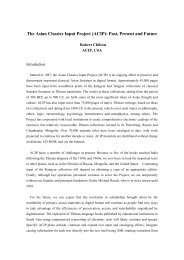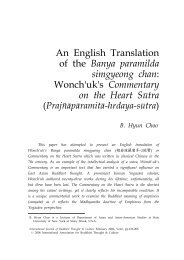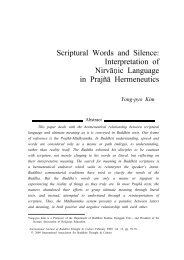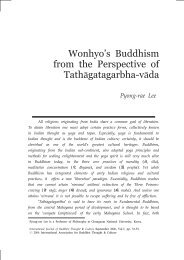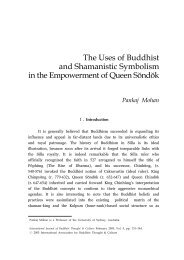Esoteric Buddhism under the KoryÅ in the Light of ... - Buddhism.org
Esoteric Buddhism under the KoryÅ in the Light of ... - Buddhism.org
Esoteric Buddhism under the KoryÅ in the Light of ... - Buddhism.org
Create successful ePaper yourself
Turn your PDF publications into a flip-book with our unique Google optimized e-Paper software.
International Journal <strong>of</strong> Buddhist Thought & Culture 63<br />
Dur<strong>in</strong>g <strong>the</strong> late 13th century when <strong>the</strong> relationship between <strong>the</strong><br />
Mongol Empire and <strong>the</strong> Koryŏ had become cordial and even<br />
harmonious, scattered attempts at <strong>in</strong>troduc<strong>in</strong>g Tibetan Lamaism to<br />
Korea took place. Despite <strong>the</strong> polite reception <strong>the</strong> various lamas<br />
received at <strong>the</strong> Koryŏ court, it appears that <strong>the</strong> form <strong>of</strong> milgyo <strong>the</strong>y<br />
thaught, i.e. fully developed Tantric <strong>Buddhism</strong>, did not meet with <strong>the</strong><br />
approval <strong>of</strong> <strong>the</strong> Koreans. Although <strong>the</strong> available sources only provide<br />
h<strong>in</strong>ts as to why <strong>the</strong> Tantric style <strong>of</strong> <strong>Esoteric</strong> <strong>Buddhism</strong> did not appeal<br />
to <strong>the</strong> Koreans, enough can be gleaned to show that it was fundamental<br />
differences as regards ethics - Buddhist as well as Confucian - which<br />
prevented Lamaism from ga<strong>in</strong><strong>in</strong>g a foothold on <strong>the</strong> Korean Pen<strong>in</strong>sula. 10<br />
Despite <strong>of</strong> this, dur<strong>in</strong>g a period <strong>of</strong> three to four decades <strong>the</strong> court at<br />
Kaesŏng and <strong>in</strong> Dadu 大 都 shared - if not exactly <strong>the</strong> same <strong>in</strong>terest <strong>in</strong><br />
Tantric <strong>Buddhism</strong> as transmitted by Tibetan Lamaism - <strong>the</strong>n at least a<br />
number <strong>of</strong> its rituals. Here it is <strong>in</strong>terest<strong>in</strong>g to note that while <strong>the</strong> same<br />
rejection <strong>of</strong> Tantric <strong>Buddhism</strong> took place <strong>in</strong> <strong>the</strong> states <strong>of</strong> Song, Liao<br />
and J<strong>in</strong>, i.e. Ch<strong>in</strong>ese or S<strong>in</strong>isized empires, <strong>the</strong> Tangut rulers <strong>of</strong> Xixia<br />
happily embraced Lamaism with its full-fledged Tantrism. 11<br />
II. Koryŏ <strong>Buddhism</strong> and <strong>the</strong> Heavenly Mandate<br />
The essential parameters govern<strong>in</strong>g <strong>the</strong> relationship between <strong>the</strong><br />
state and <strong>Buddhism</strong> were already laid down <strong>in</strong> <strong>the</strong> so-called Sip hunyo<br />
十 訓 要 (Ten Injunctions) <strong>of</strong> K<strong>in</strong>g T’ejo (r. 918-943) at <strong>the</strong> very<br />
beg<strong>in</strong>n<strong>in</strong>g <strong>of</strong> <strong>the</strong> Koryŏ. 12 Accord<strong>in</strong>g to <strong>the</strong> first <strong>in</strong>junction we f<strong>in</strong>d that,<br />
<strong>Buddhism</strong> advocated by <strong>the</strong> thaumaturge Zhao Zhifeng 趙 智 風 (1159-1225) and his followers at<br />
Mt. Baod<strong>in</strong>g 寶 頂 山 <strong>in</strong> Dazu 大 足 , Sichuan. See Sørensen (2005b: 242-250). However, <strong>in</strong> none <strong>of</strong><br />
<strong>the</strong> above cases can we really speak <strong>of</strong> fully <strong>in</strong>stitutionalized types <strong>of</strong> <strong>Esoteric</strong> <strong>Buddhism</strong>, as<br />
<strong>the</strong>y all <strong>in</strong>corporated o<strong>the</strong>r and significant elements from o<strong>the</strong>r forms <strong>of</strong> <strong>Buddhism</strong>. Moreover,<br />
none <strong>of</strong> <strong>the</strong>m had any direct historical l<strong>in</strong>k with ma<strong>in</strong>stream <strong>Esoteric</strong> <strong>Buddhism</strong> <strong>of</strong> <strong>the</strong> Tang.<br />
10 I have described <strong>the</strong> nature <strong>of</strong> this encounter <strong>in</strong> detail <strong>in</strong> Sørensen (1993b).<br />
11 See Dunnell (1992; 2001). For a discussion <strong>of</strong> Tibetan Imperial Preceptors <strong>under</strong> <strong>the</strong> Yuan, see<br />
Franke (1981).<br />
12 KS.I.54b-b. For a full translation, see Lee (263-6).



